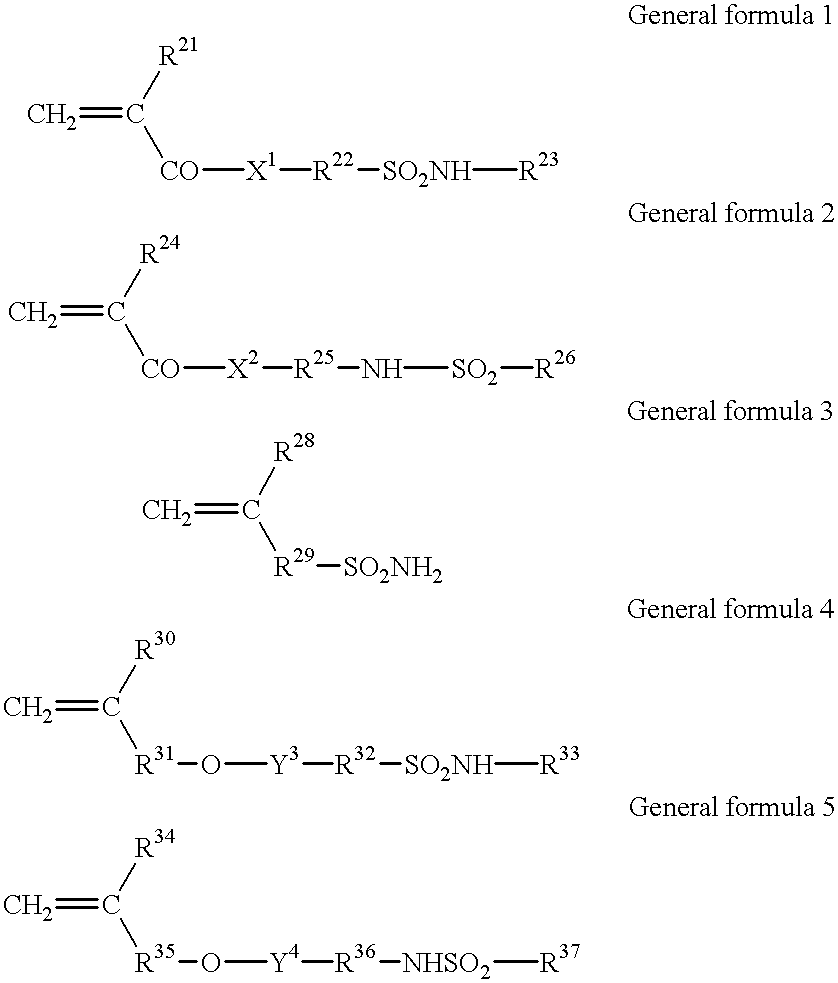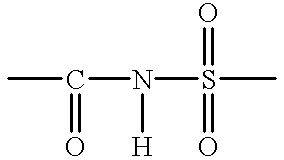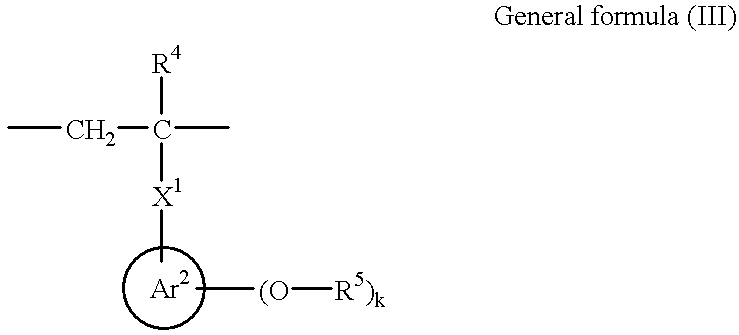Planographic printing plate
a technology of printing plate and precursor, applied in the direction of lithography, photosensitive materials, instruments, etc., can solve the problems of film remains, low sensitivity, insufficient decomposition reaction of positive photosensitive layer,
- Summary
- Abstract
- Description
- Claims
- Application Information
AI Technical Summary
Benefits of technology
Problems solved by technology
Method used
Image
Examples
example 1
[0292] Molten baths of aluminum alloys having compositions (1) to (5) shown in the following Table 1-1 were allowed to contain trace elements as shown in the following Table 1-2, to prepare molten baths of aluminum alloys containing trace elements in given amounts, respectively. After filtration of the prepared molten baths, ingots having a thickness of 500 mm and a width of 1200 mm were made, respectively, by a DC casting method. The surfaces of the resulted ingots were cut by a facing machine at an average size of 10 mm, then, heated at 550.degree. C. for about 5 hours, to carry out soaking treatments, respectively. When the temperature decreased to 400.degree. C., the ingots were made into rolled plates having a thickness of 2.7 mm by using a hot roller. Further, heating treatment was conducted at 500.degree. C. using a continuous annealing machine. Then the annealed plates were cold-rolled to obtain aluminum alloy plates having a thickness of 0.24 mm, respectively.
[0293] The res...
example 2
Examples 2-1 to 2-8 and Comparative Examples 2-1 to 2-2
[0303] Molten baths of aluminum alloys containing the following elements in addition to aluminum were prepared.
7 Si: 0.06% by weight Fe: 0.30% by weight Cu: 0.017% by weight Mn: 0.001% by weight Mg: 0.001% by weight Zn: 0.001% by weight Ti: 0.03% by weight
[0304] After purification by the above-described Al molten bath filtration, ingots having a thickness of 500 mm and a width of 1200 mm were made by a DC casting method. The surfaces of the resulted ingots were cut by a facing machine at an average size of 10 mm. Then, they were soaked at 550.degree. C. for about 5 hours, and when the temperature decreased to 400.degree. C., the ingots were made into rolled plates having a thickness of 2.7 mm by using a hot roller. Further, heating treatment was conducted at 500.degree. C. using a continuous annealing machine, then, the annealed plates were made into aluminum alloy plates having a thickness of 0.24 mm by a cold rolling machine. ...
examples 2-9 to 2-11
and Comparative Examples 2-3
[0310] Molten baths of aluminum alloys containing the following elements in addition to aluminum were prepared.
10 Si: 0.10% by weight Fe: 0.30% by weight Cu: 0.02% by weight Mn: 0.001% by weight Mg: 0.015% by weight Zn: 0.001% by weight Ti: 0.03% by weight
[0311] After purification by the above-described A1 molten bath filtration, ingots having a thickness of 500 mm and a width of 1200 mm were made by a DC casting method. The surfaces of the resulted ingots were cut by a facing machine at an average size of 10 mm. Then, they were soaked at 550.degree. C. for about 5 hours, and when the temperature decreased to 400.degree. C., the ingots were made into rolled plates having a thickness of 2.7 mm by using a hot roller. Further, heating treatment was conducted at 500.degree. C. using a continuous annealing machine, then, the annealed plates were made into aluminum alloy plates having a thickness of 0.24 mm by a cold rolling machine. In cold rolling, a rolling ...
PUM
| Property | Measurement | Unit |
|---|---|---|
| Fraction | aaaaa | aaaaa |
| Fraction | aaaaa | aaaaa |
| Fraction | aaaaa | aaaaa |
Abstract
Description
Claims
Application Information
 Login to View More
Login to View More - R&D
- Intellectual Property
- Life Sciences
- Materials
- Tech Scout
- Unparalleled Data Quality
- Higher Quality Content
- 60% Fewer Hallucinations
Browse by: Latest US Patents, China's latest patents, Technical Efficacy Thesaurus, Application Domain, Technology Topic, Popular Technical Reports.
© 2025 PatSnap. All rights reserved.Legal|Privacy policy|Modern Slavery Act Transparency Statement|Sitemap|About US| Contact US: help@patsnap.com



